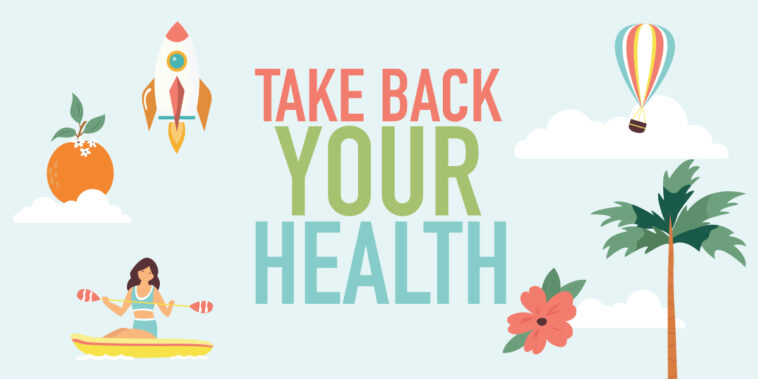This portion of our in-depth, 3-part series on refocusing, recommitting and taking care of you – mind, body and spirit – covers how to plan for a healthy hurricane season, how to stay hydrated with food and information about living a pain-free life.
6 Ways to Plan for a Hurricane During COVID-19
By Eric Alberts, Orlando Health
Out of necessity, our regular hurricane preparedness plan has been enhanced due to COVID-19. The demand for supplies is high, which will be very stressful for many, so it’s important to plan ahead.
1. Secure Your Supplies
Having an emergency kit prepared is recommended. With additional threats of infection this season due to COVID-19, you should also have masks and sanitary wipes on hand.
Begin adding to and building your hurricane kit now, as these sorts of items may be harder to find as the season progresses. Items to consider adding to your emergency kit include:
• Water (one gallon per person per day for 3+ days)
• Nonperishable food for 3+ days
• National Oceanic and Atmospheric Administration (NOAA) weather radio
• Flashlight and extra batteries
• First aid kit and fire extinguisher
• Whistle (to signal for help)
• Dust mask (to filter contaminated air)
• Plastic sheeting and duct tape
• Moist towelettes, soap, hand sanitizer, garbage bags, plastic ties
• Wrench or pliers
• Manual can opener
• Local maps
• Cell phone with chargers and/or backup battery
• Prescriptions
• Important paperwork and legal documents
• Baby supplies
• Pet food and extra water for your pet
2. Prepare Your Loved Ones
It’s essential to have a plan in place. Discuss what your family will do, and write down an emergency preparedness plan for both those you live with and others you care for, especially if they have special needs. Be ready to put your plan into action at any time.
3. Care for Your Elderly
Elderly family members should be a priority in your preparedness plan. Get any necessary medications and supplies ahead of time so they’re ready if your family needs to evacuate. Call and ask what you can provide for them: extra tissues, sanitizing cloths or prescription medications. Encourage them to step up their planning efforts as well.
4. Prepare Your Home
If you have an urgent project caused by previous damage (such as roof damage), now is the time to fix it so your home can better withstand any storms you may face. Financially plan and look for opportunities to save so you have extra funds available in case of an emergency. Prepare an emergency contact list that includes contractors and companies that can fix damages to your home following a hurricane.
5. Safely Seek Shelter
Many have asked what we can do in hurricane shelters to minimize the impact of COVID-19. The Federal Emergency Management Agency (FEMA) has new guidelines in light of the pandemic. If you’re in a shelter, remember to follow COVID-19 social distancing guidelines and use personal protective equipment such as face masks and gloves.
6. Plan Ahead
It’s especially important this year to know what you and your loved ones are going to do in case of a natural emergency. COVID-19 is still an active threat, so do what is needed now to allow you to be safer later. Heed these warnings and take them seriously by talking with your family about what you are going to do and take action.
7 Foods That Keep You Hydrated
Courtesy of Healthy West Orange
It can be easy to fall behind in your water intake during the hot summers. In addition to water and other healthy drinks, you can eat foods that contribute to your fluid intake, helping to prevent the headaches and sluggishness caused by dehydration.
Another good reason to eat water? Research shows that eating foods that are full of water helps keep you satisfied on fewer calories. Learn about these seven foods that hydrate, with expert info from the Cleveland Clinic.
1. Cucumbers
Cucumbers hydrate and replenish your skin. In addition to containing 95% water, cucumbers are rich in anti-inflammatory compounds that help remove waste from the body and reduce skin irritation. Preliminary research also suggests cucumbers promote anti-wrinkling and anti-aging activity.
2. Celery
Celery will satisfy your craving for crunch. It’s also tied with cucumbers and iceberg lettuce at 95% water by weight. You can feel good about eating celery because of its low-calorie count and high value in vitamin K, folate and potassium. It’s yummy with peanut butter, hummus or your favorite dip.
3. Iceberg Lettuce
Ice, ice, baby! This type of lettuce contains 95% water and will definitely help you stay hydrated and cool. That makes it a good hydrating base for your summer salad. However, if you prefer the heart-healthy benefits of leafy greens instead, spinach is a good alternative at 91% water by weight. All green everything!
4. Zucchini
Like its relatives in the cucumber and melon families, this summer squash has a high-water content — almost 95%. Better yet, zucchini packs in antioxidants such as beta-carotene, lutein and zeaxanthin. Those last two are especially important for eye health.
5. Watermelon
No surprise here — “water” is in the name, after all. Watermelon flesh contains 91% water. This summer treat also contains abundant lycopene, which can help protect cells from sun damage and improve your complexion.
6. Strawberries
They’re sweet enough that you can eat them for dessert, but the benefits of strawberries go beyond flavor and 91% water content. They provide a rich source of flavonoids, compounds associated with improved cognitive function. For example, one study associated eating more berries with delayed cognitive aging of up to 2.5 years.
7. Cauliflower
Surprised? Well, cauliflower is actually 92% water by weight. It’s rich in vitamin C, vitamin K and other key essentials. Try it mashed as a substitute for mashed potatoes or use it to prepare pizza crust!
So, while you’re packing your picnic lunch, don’t forget the hydrating snacks! There are so many yummy options to choose from.
Why You Shouldn’t Wait to Address Your Pain
By Lyndsay Fogarty
When it comes to health, men don’t always listen to the hints their bodies are giving them. It’s easy to tough out the pain instead of taking it as an indicator that something is up. That’s exactly what, Mike Brown and Maurice “Saki” O’Sullivan, did before turning to Dr. Troy Yeomans of Phoenix Integrated Medical Center for relief.
Brown suffered a rotator cuff injury after a fall. After several weeks of sharp pain, inability to turn his neck or head and difficulty completing simple tasks such as turning a door handle, he had two options: surgery or regenerative medicine. So he consulted with Dr. Yeomans, who suggested stem cell therapy to promote tissue repair in the affected area.
Brown visited the office for an injection into his shoulder. He now has 99% use of his shoulder with no pain, and he’s even started hitting the punching bag again for exercise – something he wouldn’t have considered before the treatment.
“It, without a doubt, made 100% difference,” Brown says. “He’s definitely helped me and kept me from several surgeries, too.”
Similarly, O’Sullivan dealt with foot pain for several months before being diagnosed with plantar fasciitis. His pain was hovering between eight and nine, and orthotics, boots and cortisone shots weren’t working. With a trip to Machu Picchu looming, he visited Dr. Yeomans on his daughter-in-law’s recommendation.
After two weeks of manipulation still wasn’t touching the pain, Dr. Yeomans suggested platelet-rich plasma therapy. PRP uses healing properties from the patient’s blood to restart the body’s inflammatory process in an attempt to heal the area faster and better than the body did on its own.
“It was fairly intimidating, but I got the PRP shot and within an hour, my pain was probably a two on a 10-point scale,” O’Sullivan remembers. “I call it my miracle.”
O’Sullivan notes that Dr. Yeomans never overpromised and that he was the only person who came up with a therapy that resolved his pain, something that many of his patients agree on.
Living in pain doesn’t have to be the norm. Visit PhoenixIMC.com to schedule an appointment and get back to a pain-free life.
Meet Dr. Troy Yeomans
Dr. Troy Yeomans, a Winter Park native, was inspired to start Phoenix Integrated Medical Center after he was faced with potential surgery following an unexpected sports injury but achieved successful results with non-surgical options instead.
During a game of softball, the familiar motion of picking up a ground ball caused a herniated disc in his back. He traveled to a doctor who worked with him on a treatment plan that included spinal decompression therapy and class IV laser therapy. It was that combination of regenerative medicine therapies that he credits with completely healing him without surgical intervention.
Dr. Yeomans has been practicing in Central Florida for 20 years. He founded Phoenix Integrated Medical Center as a metaphor for his life and rebirth in his practice but also as a symbol for how he wants his patients to feel. To learn more about solutions without surgery, call 407-637-8300 to schedule a complimentary consultation.







Comments